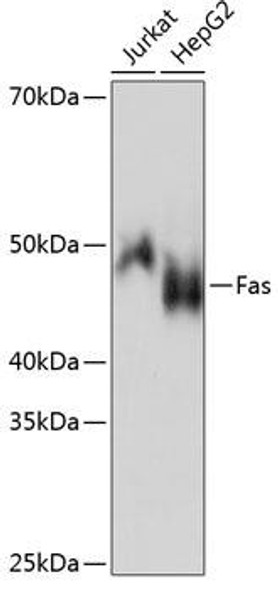Description
FAS Monoclonal Antibody [pprro-160] (CPAB0089)
The Fas Antibody (CPAB0089) is a polyclonal antibody designed for research involving Fas, a cell surface receptor involved in apoptosis, or programmed cell death. This antibody, raised in rabbits, is highly reactive with human samples and is validated for use in a variety of applications, including Western blot, immunofluorescence, and flow cytometry.Fas, also known as CD95, is a member of the tumor necrosis factor (TNF) receptor superfamily and plays a crucial role in the regulation of cell death. Dysregulation of the Fas signaling pathway has been implicated in various diseases, including cancer, autoimmune disorders, and neurodegenerative diseases.
Understanding the function of Fas is essential for developing targeted therapies to modulate cell death pathways in these contexts.The Fas Antibody (CPAB0089) enables the detection and analysis of Fas protein expression in different cell types, making it an invaluable tool for researchers in the fields of immunology, oncology, and neurobiology. By studying Fas, researchers can gain insights into the mechanisms of cell death and develop novel therapeutic strategies for treating Fas-related diseases.
| Product Name: | FAS Antibody (CD95) |
| Product Sku: | CPAB0089 |
| Size: | 100μg |
| Host Species: | Mouse |
| Immunogen: | Recombinant Human FAS. |
| Clone: | pprro-160 |
| Reactivity: | Human |
| Applications: | Flow Cytometry |
| Purification Method: | Protein-A column. |
| Isotype: | IgG2a |
| Background: | The Fas receptor (CD95) mediates apoptotic signaling by Fas-ligand expressed on the surface of other cells. The Fas-FasL interaction plays an important role in the immune system and lack of this system leads to autoimmunity, indicating that Fas-mediated apoptosis removes self-reactive lymphocytes. Fas signaling is also involved in immune surveillance to remove transformed cells and virus infected cells. Binding of FAS to oligimerized FasL on another cell activates apoptotic signaling through a cytoplasmic domain termed the death domain that interacts with signaling adaptors including FAF, FADD and DAX to activate the caspase proteolytic cascade. Caspase-8 and caspase-10 are first activated, to then cleave and activate downstream caspases, and a variety of cellular substrates that lead to cell death. Activation of JNK kinase, activation of Jun, and production of ceramide may also play roles in Fas-mediated apoptosis. Activation of fas-mediated apoptosis is opposed by I-FLICE and FAP. Viruses and tumors may escape immune surveillance in part through suppression of fas-mediated apoptosis using similar mechanisms. |
| Synonyms: | FASLG receptor, Apoptosis-mediating surface antigen FAS, Apo-1 antigen, CD95, Tumor necrosis factor receptor superfamily member 6 TNR6, APT1, FAS1, TNFRSF6. |
| Storage Buffer: | For periods up to 1 month store at 4°C, for longer periods, store at -20°C. Prevent freeze thaw cycles. |






